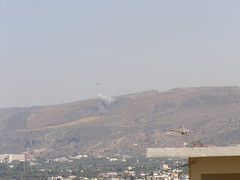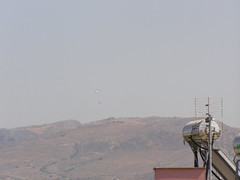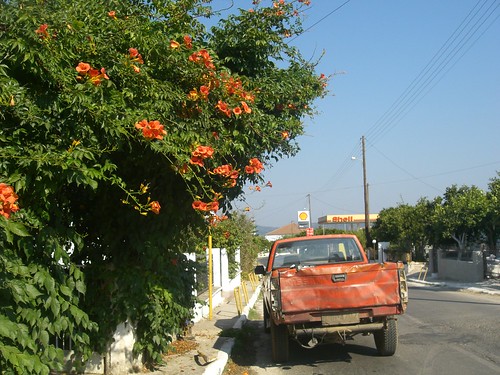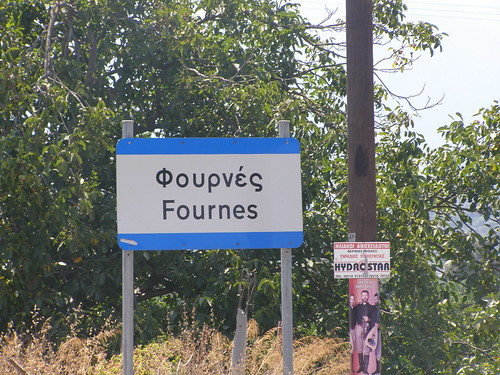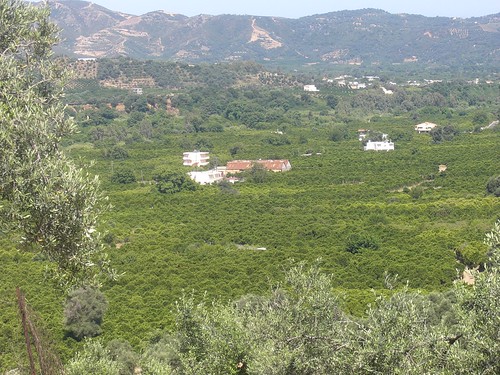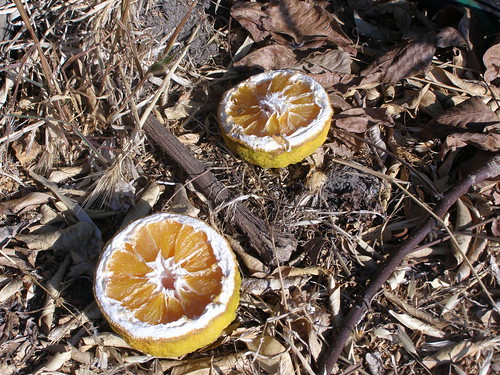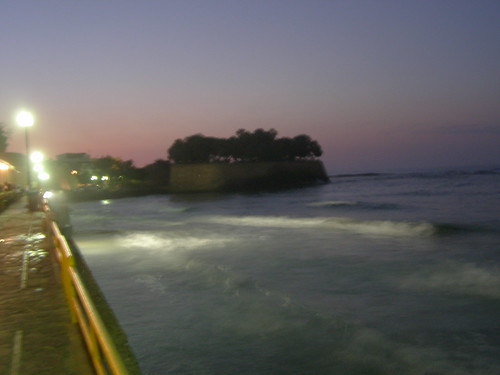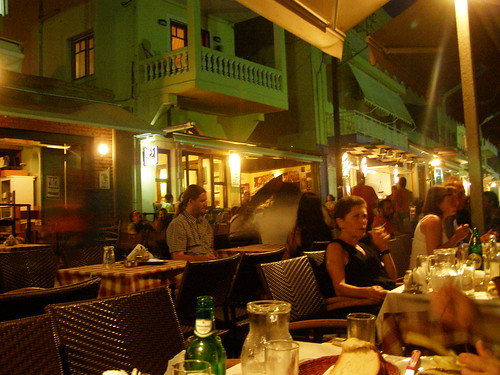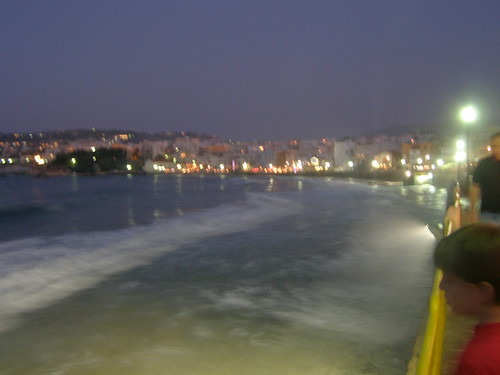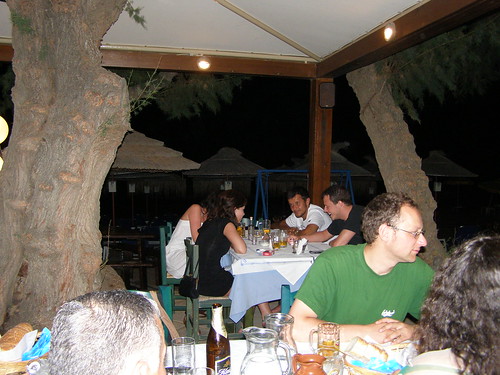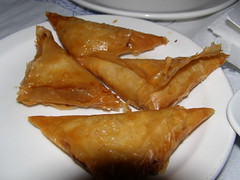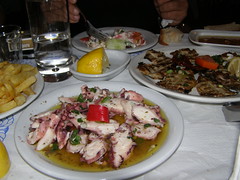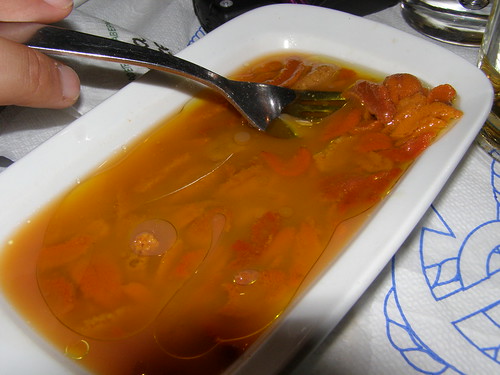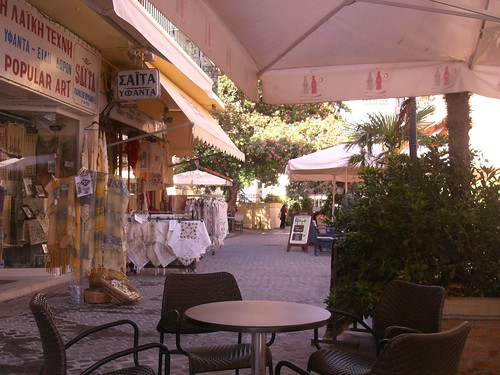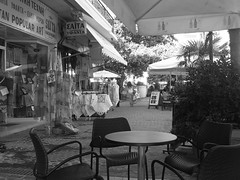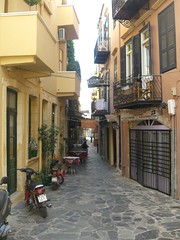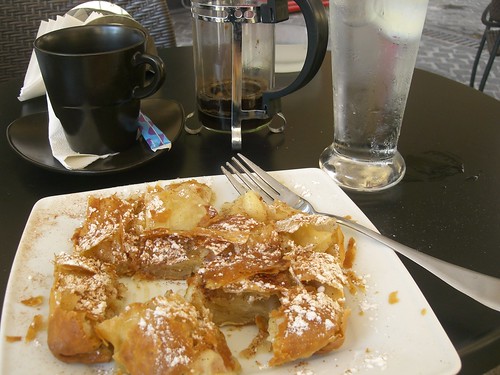The old minaret adjacent to St Nikolaos church is a perfect reminder of the way the East met the West in the town I made my home, Chania, Crete, Greece. The photographs I post all help to tell a part of a longer story that focuses on the town and its citizens, whether they are living there now, or have made their home in other parts of the world. As a newer resident, by writing about the town in this way, I am trying to put some order into the chaos that I seem to be confronted with.
Sunday 31 August 2008
Camera critters: the brooch
When I saw this bug near the bank of the river in Fournes village, I was confounded as to how something so shiny and beautifully coloured could turn out to be a creepy crawler living in the dirt. It reminds me of something which I read in my all-time favorite novel: Small Island, by Andrea Levy, one of the few books I have taken the time to read twice.
Here is the excerpt from the book, narrating a similar find to my glistening creepy crawler, in the voice of one of the main characters, Gilbert, of Jamaican origin:
"But this old RAF volunteer had seen it all before, during the war. I was looking down, unlike them big-eyed newcomer boys. I just arrive back in England and there on the pavement before me I spy a brooch. What a piece of good fortune, what a little bit of luck. Lying lost, this precious oval jewel shimmered the radiant iridescent green of a humming-bird caught by the sun. My aunt Corinne would have raised her hands to the heavens to call it a sign.
Now these were the thoughts that passed through my head in the three steps it took me to reach that brooch. One: perhaps it fall from a young woman's coat. Cha, so my blessing was another's misfortune. Two: it was an old woman that lost it from her purse; maybe the police station was the proper place to take it. And three: Hortense - this deep-green brooch would look so pretty on her. I conjured up an image in me mind. See me take the sparkling brooch to pin it to her dress, near her neck, against her smooth nut-brown skin. And look, see her touch the pin then tilt her head to charm a smile on me.
So all this rumination is taking place as I move closer. I was about to bend my knee so I could reach the brooch when hear this ... it flew away. Black flecks suddenly pitting the air. That jewel was no more than a cluster of flies caught by the light, the radiant iridescent green the movement of their squabbling backs. My eyes no longer believed what they saw. For after the host of flies flew they left me with just the small piece of brown dog's shit they had all gathered on. Was this a sign? Maybe. For one of the big-eyed newcomer boys walk straight along and step right in the muck."
Saturday 30 August 2008
From Kentucky to Kolimbari
INTRODUCTION:
People's dietary habits differ all over the world, with the result that when they leave their home territory, their dietary choices may not be available in their new place of residence. This invariably results in replacing food items that cannot be sourced in certain parts of the world with a foreign equivalent, or in extreme cases, doing without.
Kentucky Fried Chicken (KFC) is well known all over the world, but not in Hania, Crete. What happens when an American family from Louisville, Kentucky (don't pronounce the 's'), the headquarters of KFC, comes to live in Kolimbari, Chania (don't pronounce the 'C'), where KFC does not (yet) exist?
How will their dietary habits change? What substitutions and replacements will have to be enlisted in order that their daily dietary KFC doses will not suffer adversely? Is it possible for a Kentuckian to survive on the Mediterranean diet?
LITERATURE REVIEW:
The rates of obesity in the USA are constantly under discussion. The situation is being treated as an epidemic by many specialists: unhealthy diet coupled with lack of exercise and an addiction to sedentary activities, notably the internet, have led to a decline in the health of the average Americans.
In The Omnivore's Dilemma (2006), Michael Pollan points out that the average American's diet consists of corn-based food products, most of which are prepared in industrial kitchens (hence the term "industrial eater"), the kind usually served in fast-food outlets and store-bought ready meals, and eaten mainly by sitting on a couch watching television or in a fast moving car. Houses are even designed with a non-functional kitchen and just a microwave oven to heat up ready food (as Joanna Blythman claims in Shopped). Corn is fed to animals used in the consumer food market, such as chicken and beef, staple parts of the American diet. It is also used in other food products in the form of flour, preservatives and other food-related ingredients, even in the pesticides that are used to ensure a healthy bushel of corn. The problems inherent in such an agricultural system are mainly those related to non-sustainability and the cruel nature of growing food for fuel instead of starving people.
This is in stark contrast to the diet practiced by many residents of Crete, in accordance with the food pyramid of the Mediterranean diet (Verivaki, 2007-2008). Although supermarkets in Crete do sell prepared food in cans and plastic containers, it is not available in great quantities, nor is it treated as a staple food source. Fast food outlets do abound on the island, so it is expected that a Kentuckian will be using their facilities as a meal replacement service, given the absence of KFC.
While Americans source their food in supermarkets and the likes of McDonalds and KFC, the Cretans subsist mainly on local food which they have grown and harvested themselves. Although television features in various degrees of priority in both locations, there would be very few homes in Crete which do not own a table large enough for one's family to dine on, despite the fact that this worrying trend has been seen to intrude i various households on the island.
The purpose of this thesis, oops, sorry, I meant post, is to provide a descriptive account of the food lifestyle of the Hanioto-Kentuckians.
MATERIALS AND METHODS:
The data used in the thesis (of course, I meant the post) were gathered through the use of:
- casual interviews with the subjects (n = 2, no males)
- a meal prepared by the subjects in their Cretan home
- the contents of the subjects' fridge
- foods from the Mediterranean diet range presented to the subjects
1. What do you do for a living? (Sedentary jobs, no doubt...)
S1 is an occupational therapist, while S2 needed new kneecaps and hips, no doubt partly due to the archaeological digs she has been participating in for the last 25 years. There isn't a moment to sit around...
2. When you are in Crete, what physical exercise do you take? (I'll bet it's the gym...)
S2 has been swimming all her life, even though she doesn't live near the sea. She first crossed a river close to her home in Pennsylvania when she was only four years of age. S1 swam before she could walk because her mother (S2) was worried she might fall into someone's swimming pool and drown herself, so she taught her how to swim form a young age. They are both able to tackle Kolimbari Beach, which is very stony and deep, playing host to a dangerous riptide every now and then. S2 has also been known to hose down neighbours who spray her freshly washed laundry with water mixed with concrete from their newly constructed house. Although the subjects are both very active, they did not partake in the tomato pelting fight which took place between two neighbours; they were very thankful guns were not used instead.
3. How far away is your local 'fastfoodadiko'? (This place sure looks like the wop wops...)
Neither S1 nor S2 have any idea where the local souvlatzidiko is. They must miss KFC a lot.
4. Where do you eat your meals? (Oh, shit, there's a table in here...)
All meals are taken on a Shaker-design table which S2 made herself. In fact, all the furniture in their home is hand-made Shaker-style by S2, including a rug, made on a traditional Cretan weaving frame, called an argalio, and the covers of the living room suite.
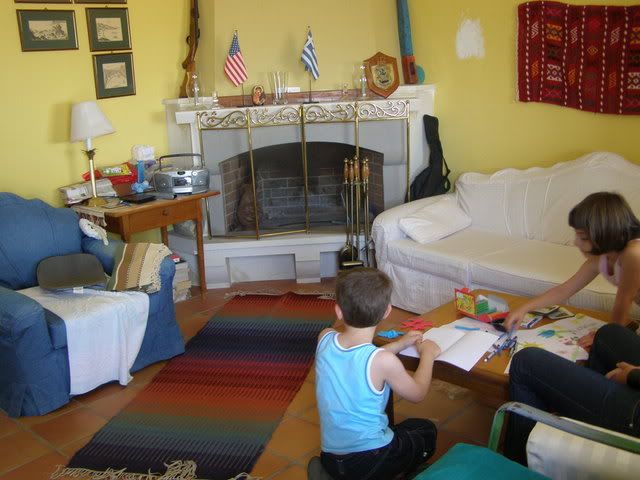
5. Where do you source your food when living on the island? (I mustn't lose my focus...)
"We grow our own weeds," they proudly told me. The garden contains lettuce, peppers and glistrida (purslane). Basil decorates the balcony as a pot plant (and I can smell it cooking in the kitchen).

6. What do you keep in your fridge? (I'm curious...)
Apart from a carton of juice and some containers full of cooling water, half the fridge had been invaded by a 15-kilogram watermelon. There were also an incredible number of corked wine bottles in the fridge, all of which have been presented as gifts (but never imbibed) from friends passing by to see them in their Cretan home in Grimbigliana, a hamlet of the coastal village of Kolimbari, west of Hania. The house itself was part of a former Turkish court, of which the fortifications and the stonework of the court, dating back to the 1700s, can still be seen today, against a background of terraced fields where wheat was once grown.
7. How often do you eat meat? (Not a cow or chicken in sight...)
Despite expecting otherwise, no corn-fed cows were to be found in the vicinity of the house. S1 is a vegetarian; she only eats chicken when she goes out for dinner in Crete and their Cretan friends deliberately over-order, as they regard her as under-fed. S2 is tired of cooking after mothering four daughters and would love to eat something cooked by anyone else other than herself. Her youngest daughter, also a vegetarian, has just had the healthiest grandchild S2 has seen so far, over 9lbs. (The answer to this question has obviated the need to ask how long it's been since the subjects had KFC).
8. Can you name these foods? (Worth a try...)
"Oh my God, you bought us some horta! Oh, you didn't bring a boureki, did you? You made courgette patties especially for us?"
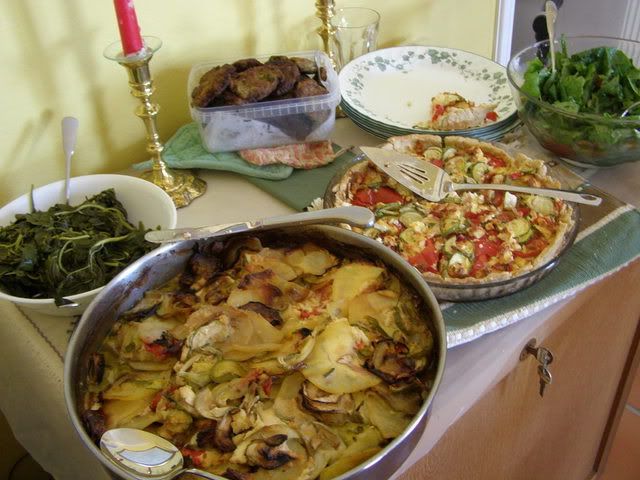
9. What are we eating today? (I'm hungry...)
S2 made a tomato and courgette quiche, using a Southern recipe for the crust. It had a sprinkling of basil on it, an unusual herb for Crete. Anne whipped up a green salad with red peppers. There was also anthotiro, a soft white local variety of Cretan cheese, and multi-grain bread from Drandakis bakery in Akrotiri.
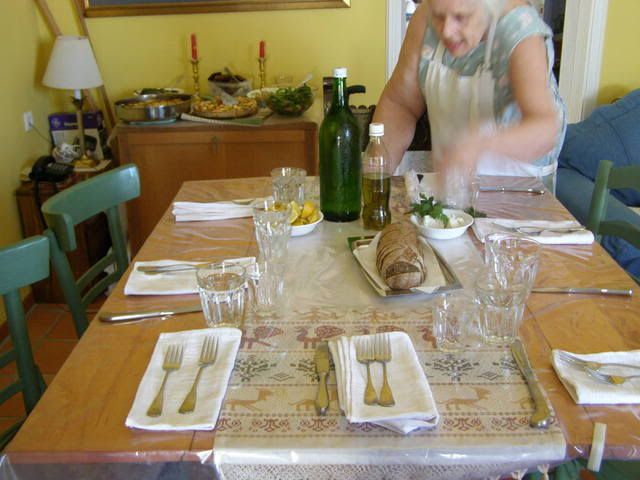
10. Why do we need two forks, Mum? (Thanks for the question, Aristotle)
I don't know, son.
11. Hey, what's that gun doing over the fireplace? Do they go hunting? (???)
Oh, go ask Alice, please, Dimitri.
12. How on earth does S1 keep so slim? (If I ask this one, I'll only be drawing attention to myself...)
DISCUSSION:
Tomato quiche with Mama's crust is finger-lickin' good.
I must remember to take back my baking tin.
The framed flag on the wall travelled from England (as a scarf on an RAF soldier's neck) to Greece, to the USA, and back to Greece again; the rudder to the right of the fireplace is from a boat owned by a friend who also owned the gun (it doesn't work).
Is there a Shaker furniture store in Hania?
Who's your daddy?
CONCLUSION:
The Mediterranean cuisine has had no effect in the dietary habits of the Kentuckians surveyed, although this must be verified with a greater sample size. Future research could focus on the availability of Cretan food in Kentucky, as this is what is actually eaten by the subjects where they live most of the time...
ACKNOWLEDGEMENTS: I am indebted to Anne Clarke and Allis for inviting me to lunch at their home in Grimbigliana, Kolimbari, Hania, Crete.
©All Rights Reserved/Organically cooked. No part of this blog may be reproduced and/or copied by any means without prior consent from Maria Verivaki.
Friday 29 August 2008
SkyWatch Friday: fire in the mountains


(right above our house with a bucket full of sea water - heading towards the fire)
CLICK ON THE PHOTOS TO ENLARGE
On Monday, a helicopter was heard in the hottest hour of the day zooming around above our house. That can only mean one thing: fire, a fire in a field, a very dangerous area for fires to break out, as most fields in Hania (and all of Crete, for that matter) have olive trees planted in them, which catch fire and burn in the space of very little time. Fires more often than not are started by someone, not something: a farmer may be burning dry tree cuttings without ensuring that the fire is extinguished before he leaves the site; someone might be clearing a field on a windy day; an arsonist might want to raze a forest area to the ground so that the state can then declare it a non-forested area (even though it previously was a forest) and building developments can take place (sadly, this occurs frequently).
I didn't pay much attention to the helicopter as this sort of thing happens frequently. It flies above our house and usually disappears beyond our view...
The bucket hanging below the helicopter collects water from the sea, and returns to the scene of the fire. It's much quicker than a fire engine, which there are not enough of to deal with the frequency of forest fires as they break out in summer. Helicopters are used in areas that are difficult to access; many olive trees are found on mountainsides with a steep incline. This helicopter passed the area quite a few times when I took the photo, which means that the fire needed a lot of work to be extinguished. Apart from helicopters, Canader planes are also used in fire-fighting.
Thursday 28 August 2008
Colours:orange
The summer sun anoints everything animate and inanimate, encasing it all in a shade akin to the golden globes found hanging on the dusty trees. Its shades are found in the terracotta urns that lie abandoned in the gardens of the old brick-orange houses, the chickens under the orange trees, the fallen citrus crop that nobody bothered to pick, the weeds that dry up in the scorching heat. Even the pick up trucks, the packing crates and irrigation pipes cannot evade the hue that Fournes is most famous for. The sun parches the ground, scorches the trees and burns the life out of the fallen crops. Yet without it, there would be no crops and rural life would cease.
(This work has been inspired from Calliope's series on Spectral Studies.)
Wednesday 27 August 2008
ABC Wednesday: F for Fournes
Fournes is the second-to-last village that you will meet on your way to the famous Samaria Gorge, the longest ravine in Europe (the last village is Lakki). It sits below the Lefka Ori mountain range. Its location, on a flat fertile plain just before the long and winding road leading to the mountains, was its greatest asset. The message one receives on passing it on their way to the Omalos valley where the gorge is located is that it has seen better days. The neo-classical designs in the old houses on the main road attest to a certain grandeur that has now become all but lost. The fields of Fournes are covered in olive and orange trees, but they often have a neglected look to them. They hint at a sign of modern times: the demise of agriculture.
The village was once considered very wealthy because its location was easily accessible, and agricultural produce was an important source of wealth. Back in the days of wealth and prosperity, people showed off their money by decorating their homes ornately, indulging in the latest fashion and dining out on a regular basis in the town. It is said that a man would get a new suit sewn every month, even if he didn't get a chance to wear the suit he had bought in the previous month. Those days are over. Olives are strewn uncollected under the trees, oranges remain on the tree even when it is producing new crops, wild thorny blackberry vines strangle olive and orange trees. The decay is obvious: rural decline in favour of urban progress.
Despite its drawbacks, Fournes still manages to lure locals and foreigners alike. The number of residents has grown slightly over the years since foreigners and wealthier citizens started building new houses in the area. This is all due to its proximity to the main town, and the plentiful agricultural occupations it offers. In the appropriate season, there is olive picking and orange packing, and if one is not averse to the sweaty toil of fieldwork, there are plenty of seasonal jobs available in the way of cleaning up fields by getting rid of thorny bushes and weeds under the trees, and generally maintaining the land, enticing in this way economic migrants. It is not a big deal to commute by car between town and village if your work is located in the urban centre (only the cost of petrol is a nuisance).
(Tomorrow I will present more photos from Fournes)
Tuesday 26 August 2008
Koum Kapi
Koum Kapi, a coastal area located eastwards of the main town of Hania, takes its name from the Turkish language, meaning 'gate of sand', which refers to the eastern gate (still standing) built into the wall that surrounded the town to guard it and its citizens in older times. Before Ottoman rule, the Venetians had already named it Sabbionara, again meaning 'sand gate'. The bulwark is now covered with trees, and there used to be a cafe operating under their shade. I was lucky enough to enjoy the view from this spot; it has closed down now.
One hundred years ago, Koum Kapi's sandy shores were once covered in straw huts, homes to the 'χαλικούτιδες' (halikoutides), the moslem servant tinkerers of Arab-African descent, who left the town during the last major population exchange in 1922 after the burning of Smyrna. The photo shows their dwellings: a rather unusual structure inhabited by unusual people. This photo has been taken from the book Chania outside the Wall, by Aimilia Kladou-Bletsa.
Koum Kapi gradually turned into another quick-build shoddy-construction ghetto: rows of workers' houses, crammed beside each other like sardines in a can, one room tacked onto the other with no town planning taken into consideration. The area resembled a slum and was considered a 'bad' neighbourhood, the kind where illicit activities take place. The area underwent major re-imaging in the mid-90s; as soon as the slum housing disappeared and the coastal road was turned into a promenade suitable for the evening volta (stroll), along came the developers, turning it into a glitzy cafe-bar neighbourhood. Before this happened, this is what it looked like (again taken from Aimilia Kladou-Bletsa's fascinating book), a little as I remember it when I first came to Greece:
It is now the most vibrant part of town, and there is never an empty seat at the eateries in good weather. It stretches along the coast starting at the right of the touristy old port, the eastern side of the Venetian city wall which is still standing; an open-air theatre operates below it, in the area of a former moat, throughout the summer. Passing St Lucia's gate, Koum Kapi ends just behind the stately Villa Koundourou, a 100-year old country house bequeathed to the state by the owner, now turned into an arts centre.
It seems that Koum Kapi is a well kept secret among the locals, as few foreign tourists are seen strolling along the promenade; while the locals walk slowly along the road enjoying the view and the misty breeze, the Northern European tourists jostle against each other for walking space at the old port in the high summer season.
It was a hot night, the theater in the moat was staging a children's play, the car park next to the theater - again housed in the moat - was choked with cars to full capacity. We were lucky to find a space near the entrance just as we were getting ready to leave it after driving right through it! This was the scariest part of the evening: getting through choking traffic with two youngsters in tow. But they weren't the only children being dragged to their parents' favorite hangout: my children met up with some of their friends from the day camp they have been attending. But the strollers were primarily young Greeks: smiling faces with bursts of laughter, all dressed in the latest fashion.
We took a walk along the promenade. The music coming from the bars, coupled with the style of the older houses, most of which have been renovated, will make you think you are on a backstreet in Havana. The food places were located closer to St Lucia's gate, while the open-air bars and cafes were found by Villa Koundourou. We walked back to find a seat in one of the little bistro-style tavernas, settling on the first place we found with empty seats. The sign above the indoor area gave its name as Kazimi. The seats were positioned next to the promenade, so that we had a direct view of the ocean, with the occassional spray of sea as the waves hit the breakwater. It felt fabulous to sit so close to the sea, but spare a thought for the locals: the music got louder and louder as the night wore on, and apparently no one goes home until well into the early hours of the morning...
We decided to order something simple: a mixed grill, more popularly known in Greek as a 'poikilia' (variety). There was a choice of small, medium and large: we chose medium for our family of two adults and two children.
'Anything to drink?' asked the not-very-talkative owner-waiter-cook.
'Two 'gazozes' for the children (locally produced cream soda), and a couple of ice-cold beers from the tap for us,' my husband replied.
'Sorry, I haven't yet bought the equipment for beer off the tap. We're new in the business, you see.' My husband was most disappointed. I wasn't too fussed; even if the food didn't come up to our expectations from this newly-opened eatery and its inexperienced owner, you have to see Koum Kapi for what it is: a good place to chill out. I wouldn't go to Koum Kapi otherwise. If all I wanted was good food, I'd stay at home. In any case, what we got for 31 euro, drinks included, was not just the food. There was also the intoxicating view and the lively atmosphere.
Admittedly, the food wasn't all home-made, judging by the chicken nuggets and uniform-sized schnitzel, but the meatballs were delicious, and the chicken souvlaki was the most succulent I had had in ages. The potato chips were crisp, but the sausages were the cheerio type, which would have gone down well at a children's party. As an added bonus, there was plenty to take home with us for the next day's lunch (2 kids count for 1 adult). It went well with the leftover boureki.

©All Rights Reserved/Organically cooked. No part of this blog may be reproduced and/or copied by any means without prior consent from Maria Verivaki.
Monday 25 August 2008
Odd shots Monday: hanging herbs
Locally grown herbs from the region of Hania, Crete, drying on the branches of a 100-year-old olive tree.
Galatas village, Hania, Crete.
Sunday 24 August 2008
Camera critters: sea snails
These snails seem to be quite cosy stuck onto the rotting wooden post of an unkempt fence at Kalamaki Beach. The owner of the house says that they are edible. They are boiled and extracted out of the shell with a pin, then dipped into an oil-garlic-vinegar dip before they are eaten.
For a completely different perspective of snail meals, click here.
Saturday 23 August 2008
Air conditioning
These unaesthetic blobs are an unavoidable sight in houses and apartment blocks throughout the country. They are the only way of lowering the temperature in a brick and mortar house which is exposed to the sun all day. The screen awning we have placed on the balcony - left - in front of this room (which happens to be the bedroom) only keeps the sun away; it doesn't lower the temperature.
Friday 22 August 2008
SkyWatch Friday: lunar eclipse
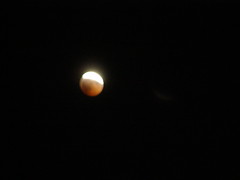

Here's what I saw of the lunar eclipse that occurred on the Saturday, the 16th of August, from Hania, Crete, Greece. I could see a shadow of the sun below the moon (second photo) which did not come out too well in the second photo. The first photo shows a zoom-in on the eclipse.
Thursday 21 August 2008
I wish I had a garden...
These pot plants were found beside the verandah of an apartment block built on an extremely noisy and dusty main road in an industrial zone, but the owner must be thankful that the flat does not face the street; despite this, the back yard of the verandah is located among a steel scrapyard, not the nicest of places to live, obviously.
The owner of the pot plants must have great affection for nature and living organisms. Maybe nature in its wild form is difficult to access for them, maybe they were born in a village, maybe they just love the colours of nature in their purest form. Whatever it is, I felt the owner's presence in this topsy turvy mix of living objects, imagining someone sitting outside in the cool evening breeze when the industrial complex has closed down after the day's business, nurturing the plants and enjoying their lot.
Wednesday 20 August 2008
ABC Wednesday: E for Eternity
It's ABC Wednesday again, and E is for eternity.
When I got married, I decided it would be for eternity. The Greek Orthodox wedding service made it sound like a grave decision that could not be overturned. The priest at St Nicholas church in the village of Galatas blessed our crowns, linked with a ribbon, joining the bride and groom, binding them for life. The crowns are kept throughout the married life of the couple, and there are even special frames available to keep them in. I wanted to put them in the same frame my parents had kept theirs in, but who knows what my father's wife did with it; at the time, I thought it impolite to ask. In any case, she ended up tearing her wedding crowns from the wall (for the second time) when she left him, which really was a waste of time and crown money in the first place.
I never got round to buying a frame for the crowns; for the last nine years, they've been hanging next to my wedding photo. I also kept a few flowers that had been used in my posh hairdo on the day of my wedding, and because I like to be fair to my husband and give him space, I salvaged a little bit of what was left of his wedding suit tie and stuck it onto the picture frame. The rest of the tie was cut up and fried, to be eaten as a dessert after the wedding banquet by his friends, according to a modern ritual. Men really are queer, aren't they?
Tuesday 19 August 2008
Outdoor fun park
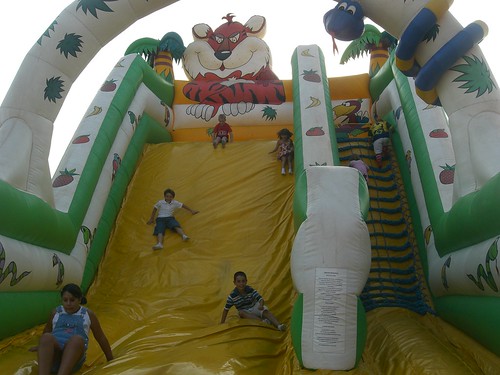
The fun park is located half a kilometre from the beach, about two kilometres from where I live. It is located at the centre of tourist activity: there is a huge INKA supermarket across the road, and the area is surrounded by hotels, tavernas and shops catering for the tourist trade. During the day, the outdoor area doesn't operate due to the harsh sun. The balloons are pumped up after 6pm, when people start leaving the beach. People kept arriving at the fun park all hours of the evening, which was a very warm one (we were at the start of a heatwave).
As a family outing, it isn't cheap; children pay an entrance fee of 5 euro, with an orange juice included, but there's also the cost of food and drinks for the rest of the family. Then there are other attractions which are not included in the entrance fee (not pictured): each go-cart costs 1 euro per ride, and there are many other similar rides to choose from. As a children's function venue, however, it is very cost-effective: others do the work for you, and you don't have to clean up afterwards.
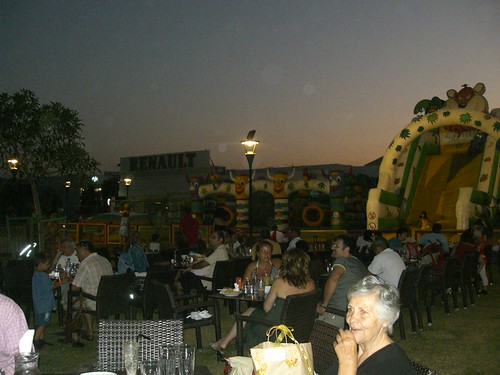
Despite living a stone's throw away from this amusement centre, which also houses a bowling alley on its roof and pinball machines indoors, I had never been there before. It has a desolate look as you pass it on the main road during the day. It is also greatly reminiscent of the plastic world we live in, with its artificial lights and well-kept lawns, despite the electricity and water shortages we face throughout the summer.
Nevertheless, I had a great time sitting in the cool evening breeze while the children amused themselves independently. Even my airy house with its top-floor balcony could not compete with this place. We got home just before midnight, having thoroughly enjoyed ourselves.
Monday 18 August 2008
Sunday 17 August 2008
Nameday
Mary, Maria, Panagiota (the One above the Saints, but presumably below God) all celebrate their nameday today, along with Mario and Panagioti. Namedays, believe it or not, are more important than birthdays. Despite the fact that many people are happy to celebrate both their name and birthday, it's the nameday that won't ever be forgotten by friends and relatives. It's also the one that evokes pleasant feelings, which is what makes Greeks the envy of the non-Greeks on such auspicious occasions:
Woman announcing her nameday: "It's my nameday today!" "Oh, really? What's your name?"
Woman announcing her birthday: "It's my birthday today!" "Oh, really? How old are you?"
And for those of you - Greeks and non-Greeks alike - who have a name which is not recognised in the religious calendar of the Greek Orthodox church (my mother's, and even my son's, don't feature in it), don't worry: there's always All-Saints Day.
So here I am, on my nameday, expecting a dozen guests to be fed and watered. In Crete, namedays are celebrated without inviting people to them. Friends and relatives will either phone to wish the celebrant χρόνια πολλά, which loosely translates as: "may you have many years of life to come", which is OK if you're not, say, 84 years old, otherwise it might sound like a curse.
Here are the choices most people select from to celebrate their nameday:
1. Have a big sit-down meal at home. This means lots of cooking and cleaning. This kind of revelry is reserved for Papa Bear: his nameday falls in the autumn, when cooking up a feast is a good way of heating up the house on a cool evening and entertaining guests indoors is the norm.
2. Have guests over at home, but serve only finger food and sweets, kind of like a buffet. I love the idea but would prefer it if someone else would make the finger food and cakes. It still means cleaning up before and after the event.
3. Go out for either a sit-down meal or finger food and sweets. This works well if you know who is coming to your nameday, because it's one of those parties which custom dictates you do not invite people to; in other words, you must make the effort to let people know where you will be instead, because you won't be at home where they may expect to find you.
4. Invite certain people to go out with you on your nameday, but not your regular well-wishers. Too elitist for us; simply not our style.
We decided to go out to a place we knew well and could hope on finding a free table. It's best to book a table if you want good food on this day, being the holiday that it is, otherwise, you have to contend with restaurants, tavernas and other food establishments that may offer a lower standard of food and service. As I have a strong opinion about where you will find very good tasty well-cooked food in Hania (only in a private house), the place I chose was selected purely on the grounds of location: it was right next to the beach, the waves could be heard crashing on the sand, and there was a small playground for the younger members of the party to amuse themselves within view of the parents. I was simply lucky that the food also turned out to be good.
Caretta Caretta has nothing to do with turtles: the name simply has a good gimmicky sound to it. We've been going to this seaside taverna for a long time now. It's located on the west coast of Hania, in a village called Agia Marina (Saint Marina). The village borders two other seaside villages which play host to the the classiest nightlife zones in Hania at this time of year: Stalos to the east, and Platanias to the west. This is where everyone comes if they want to boogie the
summer night away. Neither Stalos, Ayia Marina nor Platanias have specific borders, melding into each other in the way that neighbourhoods tend to do when they start sprawling. Once the poorest areas in the district, they are now the wealthiest. Up until the early 1950's (ie pre-mass tourism), the seaside soil was considered infertile, and lay barren-looking. It was the kind of land that refugees were gifted by the state, because it was deemed useless. Some clever person had the idea that they could build basic rooms to meet the low standards of the backpacking beach-sleeping mosquito-bitten grubby tourists at the time, and since then, Greece has been treated as a cheap holiday destination, an opinion which suddenly changed this year with the dollar crisis, or should I say the euro crisis, since our Northern European tourists are particularly feeling the sting of an expensive currency.
Every year, Caretta Caretta shows signs of improvement rather than stagnating. It offers the full range of Greek cuisine, along with internationally known pasta dishes (like carbonara) which are safe choices for the poor tourists who do not know how to ask for good Greek food by name. Along with this standard menu, it also offers some surprises, some of which we chose for my special day: grilled filleted sardines, seafood kalitsounia (better get the chef police onto them for the misuse of Greek culinary terminology), crab stuffed with a cheese filling and our all-time favorite delicacy, the most expensive meze of all, sea urchins, which are dressed with the ubiquitous olive oil and lemon juice and enjoyed as a dip with sourdough bread: a very acquired taste, but a special one nonetheless. We also ordered a seafood salad, some dakos, a plate of fried whitebait, some tasty octopus in vinegar dressing, some fried calamari a few plates of fried potatoes - they were that good. Total cost: 135 euro, for a party of 12.
©All Rights Reserved/Organically cooked. No part of this blog may be reproduced and/or copied by any means without prior consent from Maria Verivaki.
Saturday 16 August 2008
Morning coffee
Coupled with the congestion, there is the heat. Sweat poured down my back, my clothes were sticking to my skin, my head felt as if it were on fire. To make things worse, I had forgotten to fill my water bottle from my home, meaning that I was carrying extra useless weight in my bag aside from mizithra, okra, vine beans, children's books, among others. My mouth was dry, my body slowly dehydrating, and it was only half past nine. I needed a sit-down in the shade with something cool to drink.
My errands had taken up to the Agora, behind which there is a large square with cafes and bars surrounding it. I walked along the road and chose the first empty space offering ample shade; the name of the cafe and what it served did not interest me at that moment. In fact, whenever I'm eating out, the food and where it comes from never interests me, because I know that I can never be sure of the truth of anything the restaurateur claims about the menu. Luckily for those who live in Hania, when eating out, there is usually a choice of views, scenery and atmosphere to enjoy apart from the food: this is the motivating reason for me to eat out.
My view was not the most alluring: double parked cars, souvenir shops, tacky jewellery stores and other nondescript eyesores. Even the sight of the tourists who were milling about the area - a well-known tourist spot which may also be referred to as a trap by some - was not uplifting: after a certain point, one easily tires of seeing old-fashioned travel book images from a bygone era, young lasses clad in bikini tops and wraparound skirts and bare-chested men, their shoulders laden with a dusty backpack, in the middle of the town where we all conduct both our formal and informal business. As AA says, this is the image most people still have of Greece: a place where everyone lives by the sea beating octopuses on rocks and traveling by donkey. My tired feet and aching arms had not foiled my senses.
I looked up, spotting the name of the cafe: Ano kato: Serraiki Bougatsa, which could loosely be translated as "Topsy Turvy: Sweet Pie from Serres." Bougatsa from Serres? Foreign food, food that our foreign tourists are aching for, the term foreigners including urbanite Greek travellers from Athens, the kind who buy bougatsa in Athens which bears no resemblance to the bougatsa served in Hania, the kind of place a non-Cretan Greek would look for if words like boureki, dakos and stamnagathi scare them, fearing the unknown as we all do to some extent, which is why many of us will search for a Casa di Pasta restaurant in Thailand, or a burger chain in China.
"Parakalo?" Just when I was thinking that this might be a self-service cafe, the waiter had arrived, carrying a serving tray with coffees and glasses of water with lots of ice cubes. He had been busy preparing orders to be served to the local shop-owners, another one of those traditions which gives Greece a picture-postcard image: a waiter crossing the street with a tray of refreshments, specially ordered by businesspeople. No messing around with the cafetiere for them; silver service that even the plebs can enjoy. He left one of the glasses of water on my table.
Being on a diet - always one that is broken - I had left the house without having breakfast, so I decided to order some bougatsa, in full knowledge that it would contain three times the number of claories that my home-made breakfast would contain. I noticed the food display case: croissants, rolls, pastries, but which of all of them was the Serraiki bougatsa?
"A plunger coffee and a serving of bougatsa, please."
"The bougatsa's going to be ready in about ten minutes," he replied very politely. I was beginning to like this place.
"No problem," I smiled, I'm in no hurry."
He smiled too. "And you know it's the cream-type of bougatsa." Oh, the joy of being treated like a local...
As it was still early morning for some, the cafe was empty. I was being kept company by three empty seats round my table. I laid all my bags on the seat opposite mine, when it occurred to me that those inanimate objects might just have a better view than I did. I got up and changed places with the bags.
My whole world changed. No more cars and tacky souvenirs. I saw a different world: traditional handcrafts and woven textiles, a huge linden tree, the wall of the main square where the Cathedral of Hania is located. The most basic elements of the area had probably not changed since my parents' time before they left Crete to emigrate to New Zealand. I wondered whether they had walked in the same side street - probably it had not been pedestrianised in their time - before they left the country. It had the kind of look we are familiar with in those old Greek black and white movies which I used to see at the cinema in Wellington during a private screening for the Greek community.
Serraiki bougatsa was surely very different to the bougatsa traditionally served in Hania: custard instead of mizithra cheese, icing sugar and cinnamon instead of white granulated sugar. Even the filo pastry tasted different. But it was tasty and made perfect breakfast fare. If only the woman who's always serving at the counter in Bougatsa Iordanis could be as polite as the waiter at Ano Kato...
©All Rights Reserved/Organically cooked. No part of this blog may be reproduced and/or copied by any means without prior consent from Maria Verivaki.


